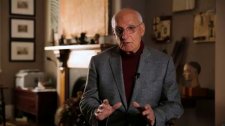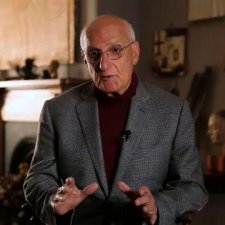I think what Rick was looking for in the portrait was the person who is the writer, and the person who is the writer is not necessarily the person that presents themselves.
When you are writing, you have to discover how your own imagination works and how you can recreate on the page something that will stir the reader's imagination in the same way. He chose to represent a person that he saw as being inward rather than expressing what's really going on there in some kind of outward or theatrical or flamboyant gesture.
Of course, before the portrait was made, I knew Rick's work. I was little surprised that he was the person who wanted to do the portrait, because I didn't know the portraits very well. What I knew was his interest in spaces, so I was bit curious when he approached me about it. The work that I really knew his was much more abstract than that, not abstract in its texture but in its interest.
My chief memory of the sessions was really what were very interesting conversations, in which I just had to talk and he did the work while he talked. I understand that, because it's a way of making the conscious mind work in one way and the hand work in another. I understand that very well from what you do with writing.
I didn't see the painting then until it was exhibited in Sydney which happened to be at Sherman's Gallery. I was surprised that it was smaller than I thought the picture had been that he was working on, and I was also very surprised by its quietness. Where it demands attention is that, if you are actually to see what's going on in it, you have to come quite close and you have to engage with it in a very quiet and personal way. That's the point at which you actually see that there's so much more going on, on that canvas.
A sense of space is often something that is a cue to a feeling or to a perception that's they are somewhere buried and that you've got to allow to come up. The writer, for example, has to be unafraid of the emptiness of his mind, because out of that emptiness that something he doesn't yet know is going to come, so the space almost seems part of what is presented in the body and the face. There's that kind of emptiness in the background.
If you're looking for some of those clues that you get in conventional portraits of the social world or the social status or the interests of the sitter, those are deliberately taken away. He was looking behind the sociable gesture or the sociable person for, I think, the person who does the writing and he lets his inward vision work to create the portrait.









